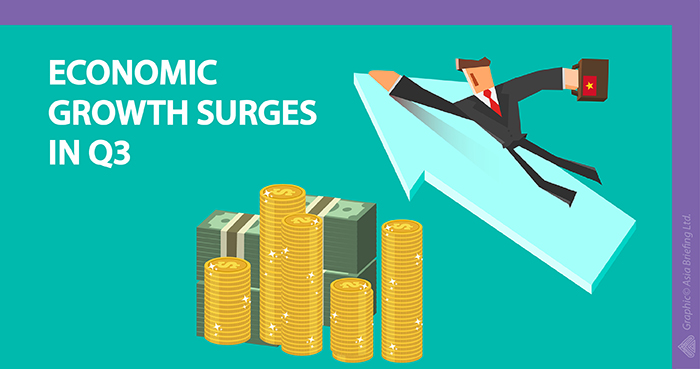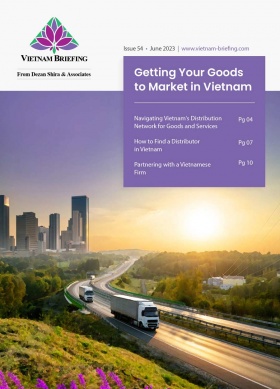Vietnam’s Growth Accelerates to 7.46 percent in Q3 2017

By: Dezan Shira & Associates
Editor: Koushan Das
Vietnam grew by 7.46 percent in Q3/2017, the highest in the last seven years. From January to September, the country grew by 6.41 percent, the strongest since 2015. This growth surge was largely driven by the industry, construction, and service sectors. According to the Vietnam Institute for Economic and Policy Research, Vietnam will continue to grow at 7.12 percent in this quarter, bringing the annual growth rate to 6.64 percent.
![]() RELATED: Pre-Investment Advisory Services from Dezan Shira & Associates
RELATED: Pre-Investment Advisory Services from Dezan Shira & Associates
Major sectors
Service sector
The service sector continued its upward trend from 2015 and expanded by 7.25 percent (YoY) in the first three quarters. Finance, banking, and insurance grew by 7.89 percent, while real estate recorded a growth of 3.99 percent.
Agriculture, forestry, and fishery
The agriculture, forestry and fishery sector grew by 2.78 percent in the first three quarters, which was higher than it’s 2015 and 2016 growth figures.
Industry and Construction
The industry and construction sector grew by 7.17 percent for the first nine months, which was much lower than the 7.68 percent and 9.72 percent growth in 2016 and 2015 respectively. This was largely due to a decline in the mining and quarrying sectors, which fell by 8.08 percent. This decline is predicted to continue for next year as well.
The construction sector grew by 8.3 percent in the first three quarters, which was positive but was less than the above 9 percent growth in the last two years.
Manufacturing sector
The manufacturing sector continued its double-digit growth for the first three quarters at 12.77 percent. The sector has been on an upward trajectory, growing by 10.15 percent and 11.22 percent for the same period in 2015 and 2016 respectively.
![]() RELATED: Facilitating SME Growth in Vietnam
RELATED: Facilitating SME Growth in Vietnam
Growing trade
Trade in Q3/2017 witnessed tremendous growth, with exports and imports growing by 21.1 percent and 21.6 percent (YoY) respectively and trade surplus reaching US$2.2 billion. Exports in the first nine months of 2017 was US$154 billion, up 19.8 percent (YoY), much higher than 6.7 percent for the same period last year. Imports grew by 23.1 percent in the first nine months to US$154.5 billion.
Until September 2017, Vietnam has a US$0.5 billion trade deficit, which is less than the US$ 2.8 billion deficit for the same period last year. Exports continue to be dominated by the FDI sector, unlike the domestic sector.
Improving consumption
Consumption in terms of total retail sales grew by 10.5 percent, up from 9.5 percent in 2016. In terms of quantity, the growth was 9.2 percent with the highest growth recorded for transports, garments, and household equipment’s at 24.9, 14.9, and 11.3 percent respectively.
The number of domestic and foreign visitors also witnessed an upward tick, contributing 12 and 14.4 percent respectively to the revenues of the accommodation, catering, and the tourism industry. The number of foreign visitors grew by 28.4 percent at 9.448 million arrivals.
Enterprises and labor
The number of newly established enterprises in Q3/2017 fell by 6.1 percent as compared to Q2/2017, but increased by 21.3 percent when compared to Q3/2016. The highest growth in newly established enterprises was in the wholesale and retail trade, manufacturing and processing, and construction sectors.
The number of new jobs created also decreased by 22.8 percent in Q3/2017 when compared to previous quarter and by 8.6 percent in comparison to last year. The total number of registered laborers in newly established enterprises also decreased by 4.5 percent from 2016 and 11.3 percent when compared to 2015. Labor growth in the foreign capital sector grew by 7.5 percent (YoY), while it fell by 3.6 percent in the state-owned enterprises.
![]() RELATED: New Inspection Regime for Foreign Owned Enterprises
RELATED: New Inspection Regime for Foreign Owned Enterprises
Foreign direct investment
Vietnam attracted around US$14.2 billion in FDI in the first 10 months, a growth of 11.8 percent from 2016. Ho Chi Minh City attracted the most investment at US$5.03 billion, followed by Bac Ninh at US$3.19 billion, and Thanh Hoa at US$3.16 billion.
Total pledges grew by 37.4 percent to US$28.24 billion in new projects, increased capital, and stake acquisitions compared to the same period of 2016. Of the total, US$16.3 billion was for 2,070 new projects (an increase of 32.9 percent), US$7.27 billion for 1,001 operational projects that required additional capital (an increase of 35.9 percent), and US$4.67 billion was for 4,156 capital contribution and share purchase projects (an increase of 58.8 percent).
The processing and manufacturing industry accounted for 48.7 percent of total investment at US$13.75 billion, followed by electricity production and distribution, and real estate at US$ 5.63 billion and US$2.04 billion.
South Korea continues to lead amongst investors at US$7.62 billion, accounting for 27 percent of the total FDI followed by Japan and Singapore at US$6.07 and US$ 5.59 billion respectively.
Economic concerns
The biggest concern for the economy going forward is the rapidly growing debt. From 2012 to end 2016, debt to GDP ratio has increased from 47.9 percent to 64.73 percent. The government is aiming for a public debt ratio below 65 percent during the 2016-2018 period. However, estimates show that debt may rise above the 65 percent threshold during the period. The growth in economic rates has not led to an increase in the country’s finances, due to numerous reasons such as corruption, overspending, and mismanagement. In addition, Vietnam will also need US$480 billion in the next four years for infrastructure development, which will be crucial for the economy.
To boost the economy, the government has taken drastic steps such as reducing interest rates in July 2017, the first time in three years. Lowering of rates will lead to an increase in loan demand and consumption; however, this can also increase credit risks adding to the already existing debt. The government has to ensure that these loans do not lead to an increase bad debt.
![]() RELATED: State Divestment: Exciting Opportunities for Investors
RELATED: State Divestment: Exciting Opportunities for Investors
2017 and beyond
Based on Q3/2017 numbers, the Vietnam Institute for Economic and Policy Research (VEPR), forecasts a growth of 7.12 percent in Q4/2017, which will increase the annual growth rate to 6.64 percent. With the increase in investment disbursement, Q4/2017 may also see an uptick in consumer demand.
Exports, driven by the growing global trade and the appreciation of Yuan, will continue its upward trend for Q4/2017 and 2018. In regards to inflation, the annual inflation rate may exceed the government’s target of 4 percent, mainly driven by an increase in domestic demand, lower interest rates, and rising GDP.
As for government targets, Vietnam is aiming for a GDP growth between 6.5 and 6.7 percent in 2018. In the trade arena, the government is aiming for growth of 7 to 8 percent in imports and exports and reducing trade deficit under 3 percent. In the short-term, the FDI sector will continue to dominate the exports, industrial output, and use of labor, but in the long-term, the domestic sector has to pick up the pace to reduce the trade deficit.
Vietnam has to focus on minimizing debt, improving its state budget, and improving the efficiency or increasing the rate of divestments of its State-owned enterprises (SOEs). In the long run, the country needs to move up the global value chain and speed up institutional reforms to create industries and newer production methods focusing on technologies and innovation, to overcome the challenges posed by the fourth industrial revolution.
|
Vietnam Briefing is published by Asia Briefing, a subsidiary of Dezan Shira & Associates. We produce material for foreign investors throughout Eurasia, including ASEAN, China, India, Indonesia, Russia & the Silk Road. For editorial matters please contact us here and for a complimentary subscription to our products, please click here. Dezan Shira & Associates provide business intelligence, due diligence, legal, tax and advisory services throughout the Vietnam and the Asian region. We maintain offices in Hanoi and Ho Chi Minh City, as well as throughout China, South-East Asia, India, and Russia. For assistance with investments into Vietnam please contact us at vietnam@dezshira.com or visit us at www.dezshira.com
|
![]()
 Dezan Shira & Associates Brochure
Dezan Shira & Associates Brochure
Dezan Shira & Associates is a pan-Asia, multi-disciplinary professional services firm, providing legal, tax and operational advisory to international corporate investors. Operational throughout China, ASEAN, and India, our mission is to guide foreign companies through Asia’s complex regulatory environment and assist them with all aspects of establishing, maintaining and growing their business operations in the region. This brochure provides an overview of the services and expertise Dezan Shira & Associates can provide.
 An Introduction to Doing Business in Vietnam 2017
An Introduction to Doing Business in Vietnam 2017
An Introduction to Doing Business in Vietnam 2017 will provide readers with an overview of the fundamentals of investing and conducting business in Vietnam. Compiled by Dezan Shira & Associates, a specialist foreign direct investment practice, this guide explains the basics of company establishment, annual compliance, taxation, human resources, payroll, and social insurance in this dynamic country.
Managing Contracts and Severance in Vietnam
In this issue of Vietnam Briefing, we discuss the prevailing state of labor pools in Vietnam and outline key considerations for those seeking to staff and retain workers in the country. We highlight the increasing demand for skilled labor, provide in depth coverage of existing contract options, and showcase severance liabilities that may arise if workers or employers choose to terminate their contracts.
- Previous Article Facilitating SME Growth in Vietnam
- Next Article Vietnam rises 14 places in the World Bank’s Ease of Doing Business Rankings










